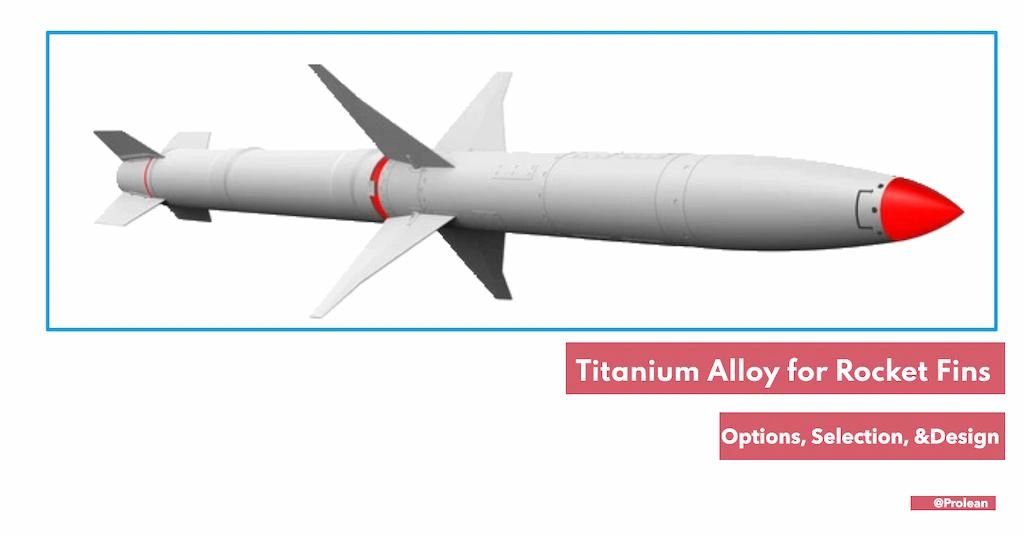
Fins are the rocket components attached to the lower body section for flight stability, control, and drag reduction. Typically, they make the rocket stable in a guided direction by resisting wind, thrust, and rotations. Traditionally, aluminum alloys and carbon composites are used to make these components. However, a high-performance titanium alloy for rocket fins can be more suitable in terms of thermal resistance, weight reduction, and strength.
Furthermore, we will elaborate use of fins on rockets, suitable titanium metal alloys to make them, and why titanium fins are essential for high-velocity rockets.
What Are the Rocket Fins?
First, let’s take a look at the fundamental structure of a rocket: It involves a nose cone at the top, a main body in the middle, and fins at the bottom section. Additionally, other components like thrust rings and mounts are also there. Each of these components has its own special functionality and role during flight.
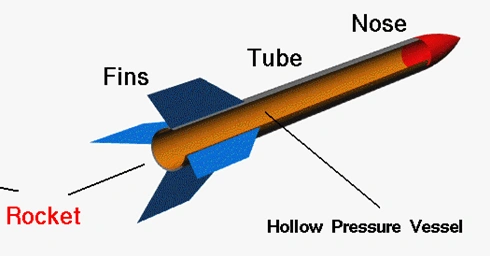
Typical structure of a rocket
The rocket fins on a rocket are the aerodynamic surfaces attached to the lower section of a rocket’s body. They can have a triangular, elliptical, or some specific geometry to provide stability in a headed direction and optimize the drag.

Side and base view of rocket fins
Riveting, bolting, welding, adhesive bonding, and direct integration as body structure are the methods to attach(assemble) the fins on a rocket body. The methods to apply depend on the rocket’s design, size, application, and material. For instance, the SpaceX Falcone 9 rocket welds the grid fins so they can withstand the intense forces of launch and re-entry, whereas traditional rockets like Saturn V (NASA) have used riveting for this.
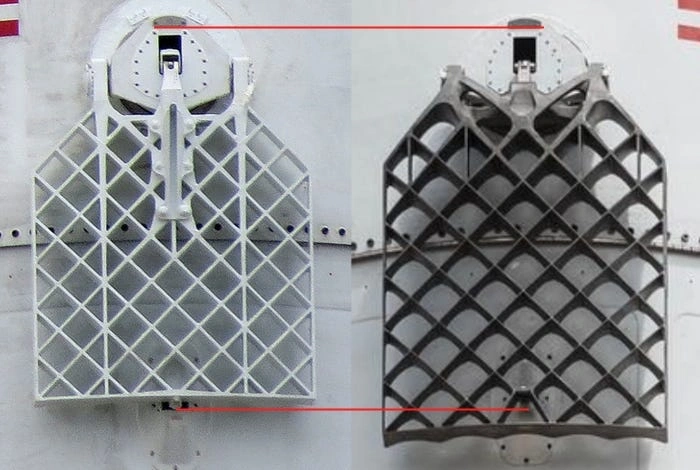
Grid fins on Falcon 9
Furthermore, the use of the right fin materials is another aspect of optimizing the rocket’s performance and lifespan; the right fin material ensures functionality under high temperature and air pressure. Nickel-chromium superalloys, composites, aluminum, steel, and titanium alloys are some common choices for rocket fins.
Try Prolean Now!
Why Titanium Alloy for Rocket Fins?
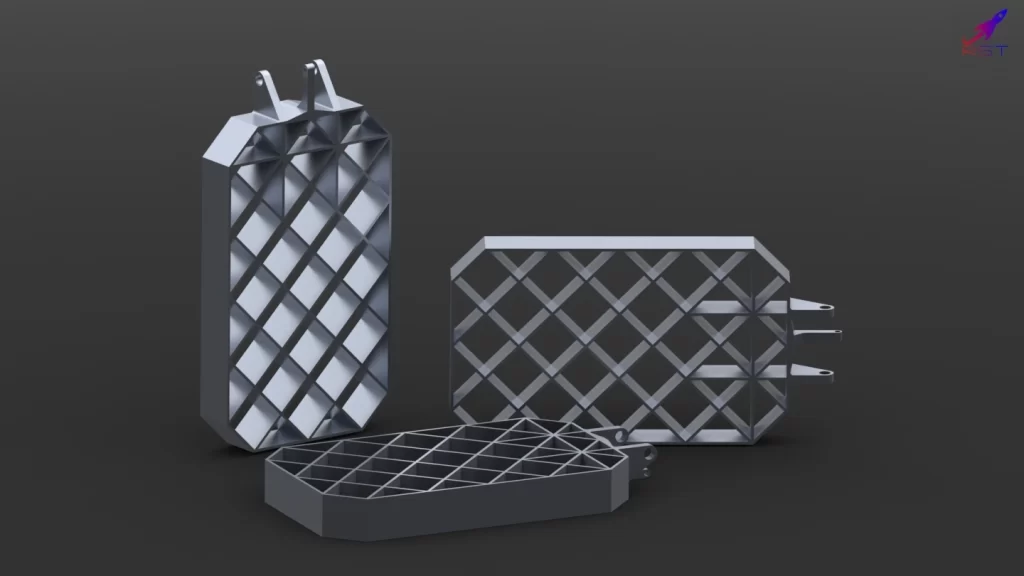
Titanium rocket fins
One of the main things to know before why titanium alloy for rocket fins is whether the rocket has a metallic or non-metallic body; some are made with metal, and some use high-performance composites. Titanium alloy fins are more suitable for metallic rockets.
The reasons behind the use of titanium metal alloy are the high strength-to-weight ratio, resistance against harsh environments, durability, and design flexibility. Titanium alloys have more durability for high-speed rockets (like supersonic), especially in the context of titanium Vs stainless steel and Vs aluminum.
- Lightweight
Titanium alloys (like Ti-6Al-4V) are lighter than other metals while offering good strength. The ratio of strength to weight is greater than 0.8 for most of them. This weight reduction without compromising structural integrity is essential for both aerodynamic and fuel efficiency.
- Thermal Stability
The melting point of titanium is 1725°C, and its alloys have a melting point above 1500°C. It maintains the structural integrity and performance when a rocket faces immense air resistance & friction in its trajectory.
- Protection from Corrosion
Titanium alloys are highly resistant to corrosion, including oxidation at elevated temperatures, which is very critical for reusable rockets. It maintains integrity over time and reduces the need for maintenance. Furthermore, the coating of superior material on titanium fins further enhances the corrosion resistance.
- Ease of Manufacturing and Design Flexibility
Advanced techniques (plasma cutting titanium, machining, casting, etc) allow the production of complex titanium components like grid fins. So, the engineers get the freedom to incorporate aerodynamically optimized fins in the design. Although the machinability of titanium metal alloys ranges between 15 and 45 %, the right tooling in muti-axis CNC machines can accurately craft them in the desired shape. ( You can read titanium machining comparison with steel here: machining titanium vs steel).
What Are the Suitable Titanium Alloys for Rocket Fins?
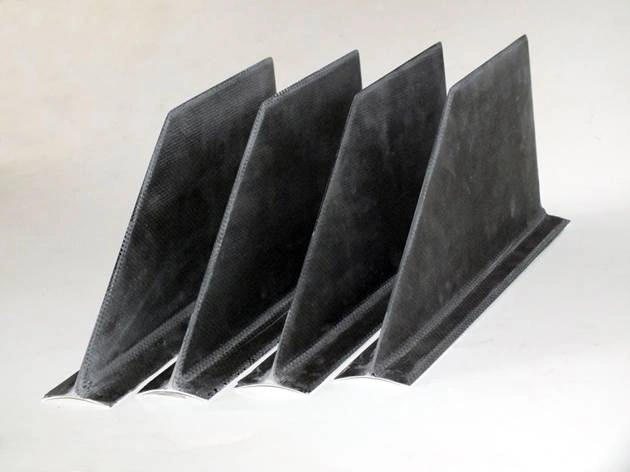
Titanium for rocket fins
Different titanium alloys are suitable for the rocket fins, especially for rockets with longer flight times and faster speeds. The table below outlines them, including composition and key properties.
| Alloy | Alloying Composition | Key Properties |
| Ti-6Al-4V | 6% Aluminum, 4% Vanadium | High strength-to-weight ratio, excellent corrosion resistance, good weldability |
| Ti-5Al-2.5Sn | 5% Aluminum, 2.5% Tin | Good weldability, stability, and strength at elevated temperatures |
| Ti-6Al-2Sn-4Zr-2Mo | 6% Aluminum, 2% Tin, 4% Zirconium, 2% Molybdenum | High strength, excellent corrosion resistance, maintains properties at high temperatures |
| Ti-6Al-4V ELI | 6% Aluminum, 4% Vanadium (Extra Low Interstitials) | Improved ductility and fracture toughness, excellent biocompatibility |
| Ti-6Al-2Sn-4Zr-6Mo | 6% Aluminum, 2% Tin, 4% Zirconium, 6% Molybdenum | High strength, excellent creep resistance at elevated temperatures |
How to Choose the Right Titanium Alloy for Rocket Fins?
As discussed just before, there are different types of titanium alloy for rocket fins. The selection process is a very complex and analytical task. Engineers run several simulations under different scenarios, like extreme temperature, speed variation, wear & tear rate, etc. Sometimes, custom alloy compositions are used instead of standard alloy grades.
The following are the main considerations for the selection process
Required Properties
One common factor is required properties; tensile strength, fatigue resistance, ductility, toughness, weight, etc. Based on which type of rocket you are making the fin for ( launch vehicle, hypersonic, space launch, etc), the right titanium metal alloy should be able to fulfill all property requirements.
Oxidation Resistance
The alloy needs to resist oxidation at varied atmospheric conditions. So, consideration of how the rocket fins will behave as environmental conditions change is essential.
Objective of Rocket
The type of titanium alloy suitable for fins also depends on the mission profile of the rocket; whether it is an orbital or sub-orbital mission. Orbital rockets need highly robust fins to obtain stability during ascent and possibly re-entry.
Try Prolean Now!
The Best Fin Design for Rocket

Different types of rocket fins
Elliptical, trapezoidal, grid, Delta, and clipped delta are some popular rocket fin designs. Which one is best depends on the size, speed, material type, and flight conditions.
Before going into the design, let’s understand the basic terminologies with a schematic diagram of the rocket fin.
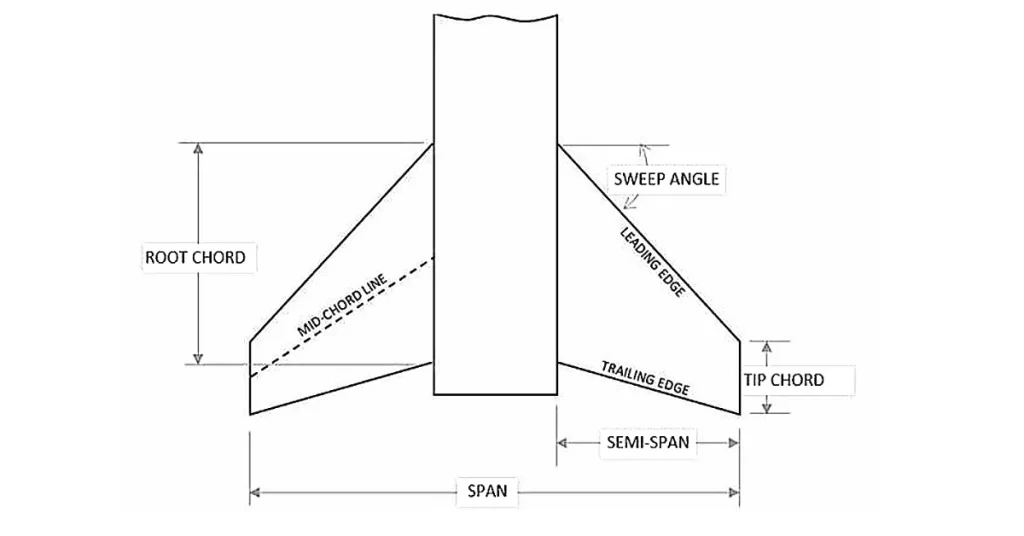
Rocket fin schematic diagram
The main goal of the best fin design for a rocket involves perfectly balancing the rocket’s center of mass relative to the fin’s COG (center of gravity). So, the rocket motion will be straight up in a determined trajectory.
Now, let’s discuss different types of fin designs;
Elliptical Fins
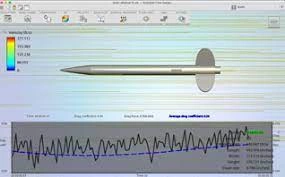
Elliptical rocket fin simulation
These are the most common types of fin designs, defined by a smooth and rounded geometry with minimal drag.
- Elliptical fins are best for small-sized subsonic rockets and models.
Trapezoidal Fins
Trapezoidal fins include straight edges and a trapezoidal shape. They are common in model rockets and experimental projects.
- Best for subsonic flight where shock lines align.
Delta and Clipped-delta Fins
These fin designs are used in high-performance rockets to achieve better aerodynamics. The delta fins involve a triangular shape with sharp leading edges, whereas the clipped delta is a modified version with shortened trailing edges.
- Delta fin designs are the best for large or high-speed rockets, e.g. transonic rockets and military missiles.
- Clipper-delta is favorable for rockets with supersonic speeds, where stability is highly concerned.
Grid Fins
These are the lattice or grid-like fins, which are preferred for greater control and stability. Grid fins have been used in many popular spacecraft, such as SpaceX Falcon 9 and CASC’s Long March 2F.
- Grind fins are best for controlling descent and re-entry at various speeds
Read More: Titanium for iPhone
Get Titanium Machining Parts from ProleanTech
Machining titanium and its alloys are relatively more challenging than other engineering metals, so they require advanced facilities and expertise to produce complex items like rocket fins.
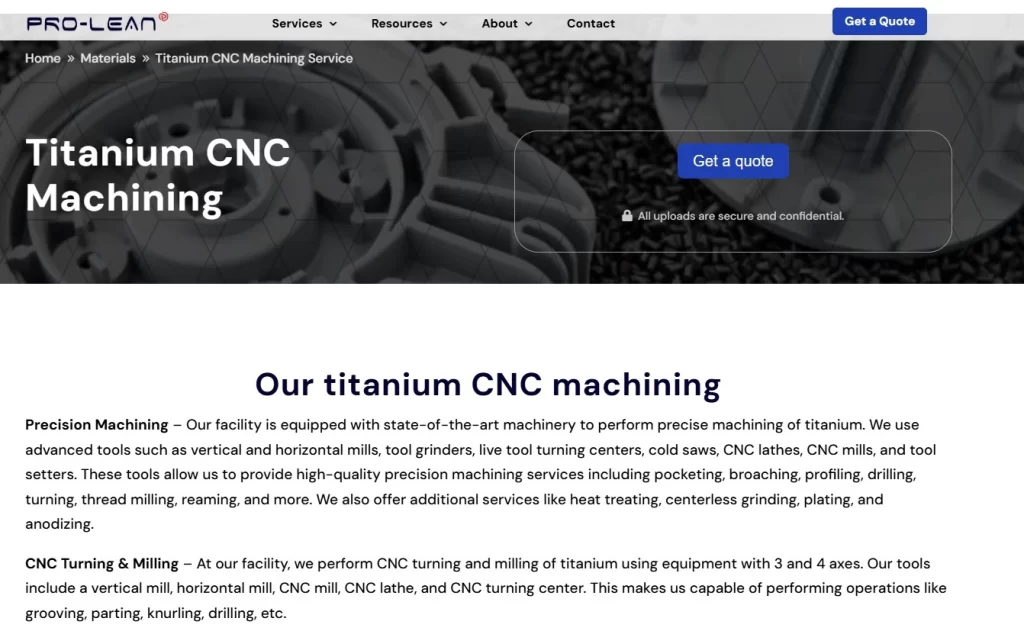
At ProleanTech, we have muti-axis (3, 4, 5-axes) CNC machines that handle intricate designs with high precision and accuracy. Consequently, tungsten-carbide and diamond tooling allow us to machine any hard titanium alloy. Our engineers have extensive experience in the production of titanium parts for air and spacecraft.
The client-centric communication approach and personalized assistance from our expert will streamline the procurement process. So, request a quote for titanium machining services today to start your project.
Try Prolean Now!
Conclusion
Titanium alloy for rocket fins provides excellent thermal stability and wear resistance under harsh flight conditions. Orbital, sub-orbital, space shuttles, small-models, and other types of rockets use different variations of titanium alloys to make the fins. Consequently, fin-making involves advanced techniques like CNC machining, plasma cutting, and metal casting.
Overall, titanium alloy can be used for fins unless the rocket is for some specific interplanetary or innovative uses.
FAQs
What are the materials for rocket fins?
Metal alloys, composites, and even wood can be used for the rocket fins. The specific choice depends on purpose, size, and design.
Why are clipped delta fins good for rockets?
Clipped delta fins are a special design involving a triangular shape with a truncated tip resembling a clipped delta wing. This design enhances the aerodynamics of rockets to counter the drag efficiently.
Which titanium alloys can be used for rocket fins?
The commonly used titanium alloy for rocket fins are;
- Ti-6Al-4V (Grade 5)
- Ti-10V-2Fe-3Al (Grade 12)
- Ti-6242S (Grade 6)
- Ti-6Al-2Sn-4Zr-2Mo (Grade 24)
- Ti-5Al-2.5Sn (Grade 17)
Does fins material affect rocket control and stability?
Yes! The type of material used to make fins affects the rocket control and stability. The physical, mechanical, chemical, and thermal properties of each material are different, impacting their performance.

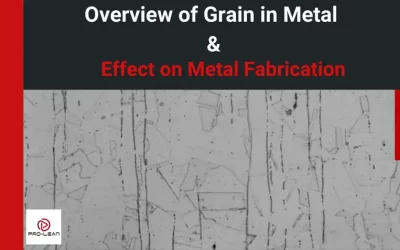
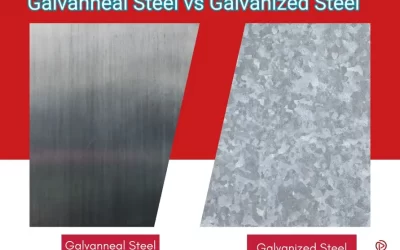
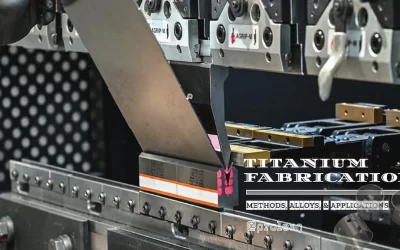
0 Comments